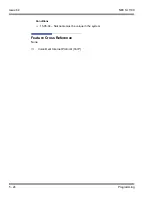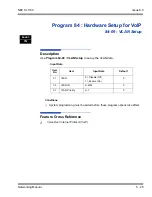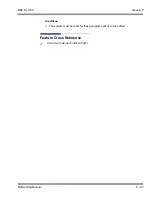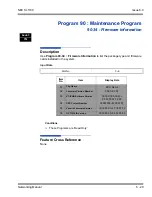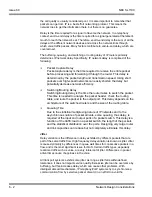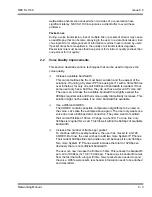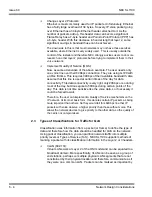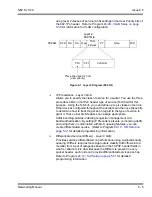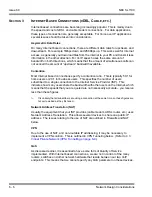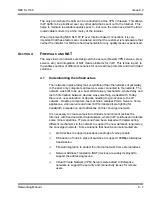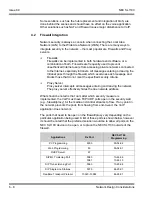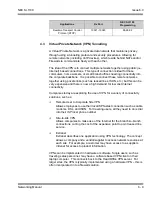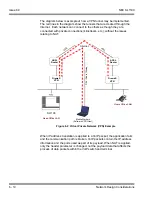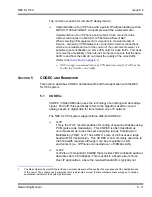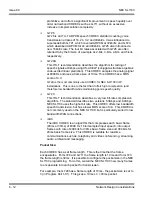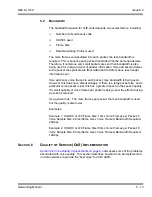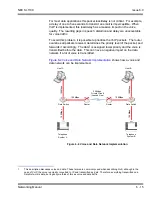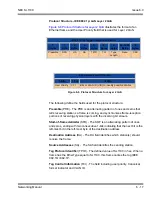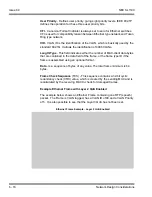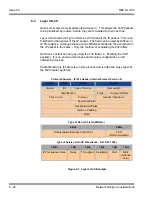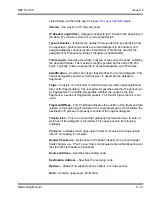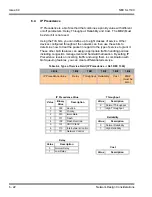
Issue 6.0
NEC SL1100
6 - 8
Network Design Considerations
Some solutions, such as the hub replacement and integration of QoS, are
done behind the scenes and should have no effect on the voice application.
Other solutions such as NAT and Firewall cause major disturbance to VoIP.
4.2
Firewall Integration
Network security is always a concern when connecting the Local Area
Network (LAN) to the Wide Area Network (WAN). There are many ways to
integrate security in the network – the most popular are Firewalls and Proxy
servers.
Firewalls
Firewalls can be implemented in both hardware and software, or a
combination of both. Firewalls are frequently used to prevent
unauthorized Internet users from accessing private networks connected
to the Internet, especially Intranets. All messages entering or leaving the
Intranet pass through the firewall, which examines each message and
blocks those that do not meet the specified security criteria.
Proxy Server
Proxy server intercepts all messages entering and leaving the network.
The proxy server effectively hides the true network address.
What should be noted is that no matter which security measure is
implemented, the VoIP must have TCP/UDP ports open in the security wall
(e.g., firewall/proxy) for the media and control streams to flow. If any point in
the network prevents the ports from flowing from end-to-end, the VoIP
application does not work.
The ports that need to be open on the firewall/proxy vary depending on the
particular application being used. A list of these ports is shown below, however
it should be noted that the preferred solution would be to allow all ports on the
NEC SL1100 device to be open, or to place the NEC SL1100 outside of the
firewall.
Applications
Rx Port
NEC SL1100
Programming
PC Programming
8000
90-54-02
Web Programming
80
90-54-01
DHCP Server
67
SIP MLT Listening Port
5080
5081
10-46-06
10-46-13
SIP Trunk Listening Port
5060
10-29-04
SIP Single Line Stations
5070
84-20-01
Realtime Transport Protocol
10020~10082
84-26-01
Summary of Contents for SL1100
Page 1: ...Networking Manual NDA 31190 Issue 6 0 SL1100...
Page 2: ......
Page 4: ......
Page 22: ...Issue 6 0 NEC SL1100 1 2 Introduction THIS PAGE INTENTIONALLY LEFT BLANK...
Page 62: ...Issue 6 0 NEC SL1100 5 30 Programming THIS PAGE INTENTIONALLY LEFT BLANK...
Page 94: ...Issue 6 0 NEC SL1100 6 32 Network Design Considerations THIS PAGE INTENTIONALLY LEFT BLANK...
Page 134: ...Issue 6 0 NEC SL1100 8 10 DHCP Client THIS PAGE INTENTIONALLY LEFT BLANK...
Page 159: ...NEC SL1100 Issue 6 0 Networking Manual 9 25 Figure 9 7 Log In to IP Phone...
Page 181: ...NEC SL1100 Issue 6 0 Networking Manual 9 47 Figure 9 25 IP System Operation Setup...
Page 206: ...Issue 6 0 NEC SL1100 9 72 IP Multiline Station SIP Figure 9 36 NAPT Configuration Example...
Page 230: ...Issue 6 0 NEC SL1100 10 18 IP Single Line Telephone THIS PAGE INTENTIONALLY LEFT BLANK...
Page 232: ...Issue 6 0 NEC SL1100 11 2 NAPT Figure 11 1 NAPT Configuration Example...
Page 242: ...Issue 6 0 NEC SL1100 12 4 All DSP Busy Indication THIS PAGE INTENTIONALLY LEFT BLANK...
Page 290: ...Issue 6 0 NEC SL1100 13 48 SL Net THIS PAGE INTENTIONALLY LEFT BLANK...
Page 291: ......
Page 292: ...SL1100 Networking Manual NEC Corporation of America Issue 6 0...

